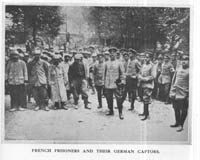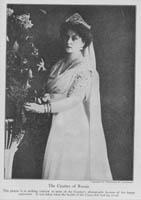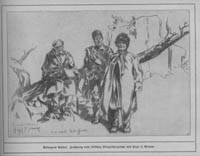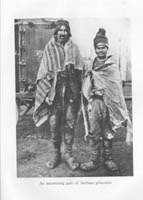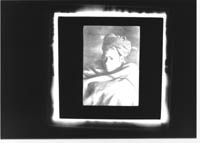Table of Contents
Media Index
CHAPTER 8
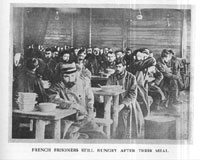
Furlorn French prisoners have finished their dinners in an unidentified German prison camp but their stomachs remain hungry. This photograph depicts the harsh conditions prisoners faced as a result of the Allied blockade.
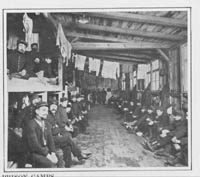
Dejected French prisoners of war sit on their double bunk beds or on the floor of their barrack in a German prison camp. Their laundry hangs to dry on a wash line near the rafters. The prospect of waiting for the war to end was a psychological challenge to most men in captivity.
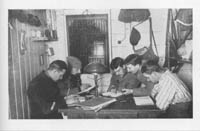
Five French prisoners sit at a table reviewing a lesson after a hard day at work. Their quarters reflect a degree of comfort in that they have access to a table lamp, stationery, and tobacco (two POW's are smokinkg pipes). Many of their belongings hang on the wall or sit on shelves. Given their standard of living, these men may be French non-commissioned officers.
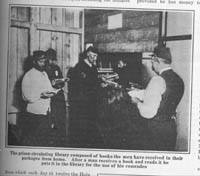
French prisoners borrow books from an unidentified prison camp library in Germany. POW's who received books in parcels from home often donated their books to the camp's circulating library to share with other prisoners.
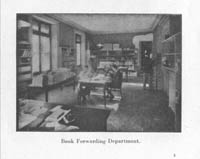
World Alliance secretaries prepare books for shipment to prisoners of war in Allied and Central Power prison camps from the Geneva headquarters. Prisoners could request books, usually Scriptures or religious tracts, directly from the World's Alliance. Rudolf Horner directed the Book Forwarding Department for the World's Alliance.
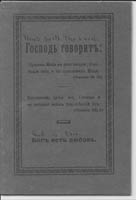
The YMCA and other Christian organizations printed and distributed a wide range of religious tracts to provide solace to prisoners of war caught behind barbed-wire. The German WPA printed this prayer book, "Thus Saith the Lord," to comfort Russian POW's.

The Board of Education in London issued this appeal for books or funding to send text books to British prisoners of war who sought to continue their educations while in prison camps. This was an opportunity for POW's to pursue educations to complete their academic programs or obtain a better job after repatriation.
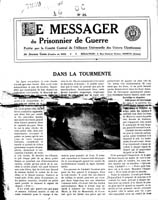
The World's Alliance of YMCA's published "The Messenger to Prisoners of War" in a wide range of languages for prisoners of war in Allied and Central Power hands. This issue was the French version, published in December 1917, and distributed in German prison camps. The YMCA sought to provide POW's with educational and devotional readings to help prisoners pass their time and improve their future lot in life.
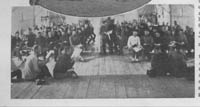
This photograph shows a classroom in a YMCA hall in an unidentified German prison camp. Russian POW's are learning how to read from fellow prisoners. The class is obviously popular--students must sit on the floor because there are no empty seats in the room.
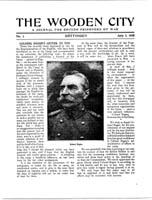
This is the front page of the first edition of "The Wooden City: A Journal for Prisoners of War" in the prison camp at Goettingen. French prisoners at Goettingen received their own newspaper in the Spring of 1915 and this issue began a news service in English. Prisoners could receive news about events in camp, sports scores, church services, humor, and other items of interest.
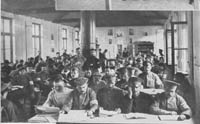
Another photograph of the reading room and library at Cassel. French and Russian prisoners enjoy a wide range of reading materials in the library.
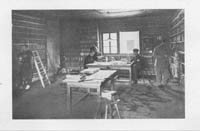
Photograph of the Internationale Bibliothek in the prison camp at Giessen. The walls of the room are loaded with shelves of books and the window is covered with wire netting. The camp library was one of the most popular locations in a prison camp isnce reading was an important pastime for many POW's.
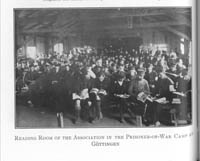
British, Russian, French, and Belgian prisoners of war cram into the reading room of the YMCA hall at Goettingen. They have access to books and pre-war magazines in the Association library. To maximize capacity within the hall, the YMCA provided benches, but not tables.
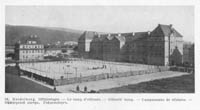
This is an exterior view of the four-story prison facility for officers at Heidelberg. The photograph clearly shows the three tennis courts and exercise ground within the compound. A tennis match is underway in the center court.
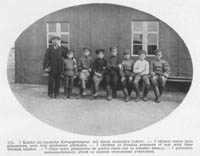
Six young Russian prisoners of war sit on a bench outside of their school house in an unidentified German POW camp during World War I. The pupil's teacher, in the straw hat, stands next to another your Russian to the left. These boys followed their fathers into the ranks during the Russian army mobilization and received an education during their incarceration.
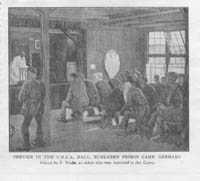
F. Wade drew this picture of a religious service in the YMCA Hall at Ruhleben. A minister delivers a sermon from the pulpit to a packed congregation. The Association made the hall available to members of any faith as a means to promote spiritual life within the prison camp.
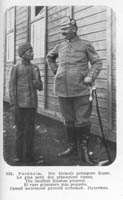
This photograph of a boy prisoner looking up at a large German guard became famous for propaganda purposes in the West as it demonstrated mighty Germany subjugating the weak. While the boy is identified as "the smallest Russian" in the prison camp at Puchheim, his uniform suggests that he is a Serbian soldier. Both the Russian and Serbian armies employed young boys as powder monkeys and for other duties. Some boys simply followed their fathers into the ranks when the war began. The boy is carrying a loaf of bread under his arm. He is facing a Bavarian officer, as indicated by the Bavarian coat of arms on his Pickelhaube (spiked helmet), and the sword at his side.
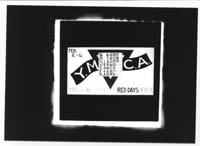
A poster from an unidentified German prison camp announcing "YMCA Days," a week long event which promoted War Prisoners' Aid services in the facility.
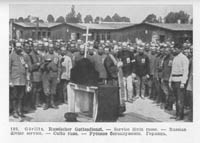
A Russian Orthodox priest in vestments holds a divine service in the prison compound at Goerlitz in front of a make-shift altar. Wooden barracks stand in the background of the photograph.

Students and their teachers pose for a photograph outside of the school house at the internment camp at Holzminden. German authorities had to provide additional social services to support the women and children incarcerated in civilian internment camps.
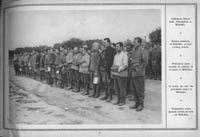
With their hats in their hands, Russian prisoners participate in a prayer at Wirballen. These prisoners may have been on a labor detachment assignment and they may be reciting a dinner prayer, as suggested by the dinner pails carried by several of the POW's.
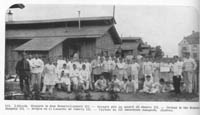
Group of French, Belgian, and Russian war prisoners at Reserve Lazarette III in Luebeck. Note that the German orderlies are wearing black, white, and red arm bands, the German imperial colors.
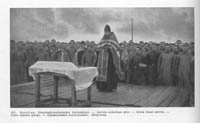
An Orthodox priest conducts an outdoor service for a large group of devout Russian prisoners of war at Sprottau on a makeshift platform and altar.
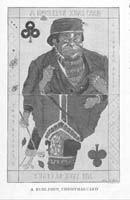
The British internees at Ruhleben designed this Christmas card, depicting a jack of clubs, complete with a set of golf clubs. The prisoners' Christmas cards attempted to inject a bit of humor during a time of year when prisoners were especially home sick.
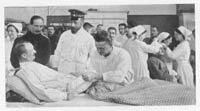
A German medical officer supervises the application of a fresh bandage to the stump of a prisoner's leg in a hospital ward at Ingolstadt. In the background, German nurses bandage another prisoner's head wound. Attentive German medical service helped a large percentage of Allied sick and wounded recover and survive the war.
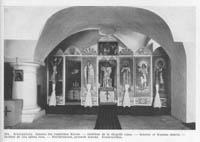
Russian Orthodox prisoners in Koenigstein (Russian and Serbian POW's) worshipped in this ornate chapel at Koenigstein. The altar has a number of candles and a painting of Christ triumphant above it; to the left is another altar with three vessels, probabaly containing sacred oils, with a painting of Christ praying in the Garden of Gethsemane. There are five additional paintings which serve as panels: Christ on the cross; the Virgin Mary holding the Christ child; Jesus; an archangel; and a king. A painting of the Lord's Supper is positioned above the panels.
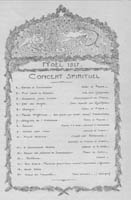
To celebrate the Christmas season, the French prisoners organized a special concert for December 1917. This program describes the music performed at Muensingen (the Christmas celebration for Russian and Serbian prisoners would follow in January 1918 due to the Orthodox calendar).
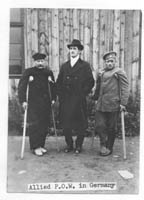
An unidentified Association secretary stands between two severely wounded Russian prisoners outside of a barrack in the compound of a German prison camp.
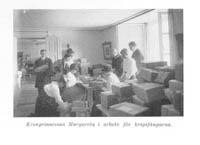
Crown Princess Margaret of Sweden (1882-1920) established a relief system for Allied prisoners of war in Germany during World War I and worked closely with the American YMCA in support of the WPA program. She is standing to the left supervising the labeling of relief packages for British POW's. She established a warehouse in her palace in Stockholm to collect clothing and provisions for shipment to Germany. Born a British princess (Princess Margaret of Connaught) and a granddaughter of Queen Victoria, she married Crown Prince Gustav Adolf of Sweden, but died suddenly in 1920.
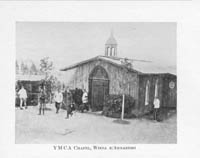
Allied prisoners leave the chapel, constructed by the YMCA, at the officers' prison camp at Wiesa bei Annaberg in Saxony.
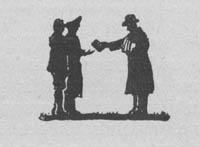
Social workers and neutral inspectors often visited prison camps to meet prisoners. In this wood block print, a social worker, probably a YMCA secretary, distributes books to prisoners of war at Muensingen.
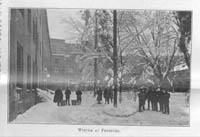
Allied officers stand in the snow in the courtyard of the prison camp at Freiburg. The officers' camp was located in the old university building in the town and the prisoners had access to the quadrangle. As demonstrated by the heavy now on the branches of the trees, a snow storm just ended.
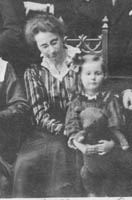
Photograph of Mrs. Hoffman and Louise Hoffman, the wife and daughter of Conrad Hoffman, the Senior WPA Secretary in Germany, taken in Lausanne, Switzerland in February 1917. They had just left Germany on the U.S. Ambassador's special train after the United States government severed diplomatic relations with the German Empire.
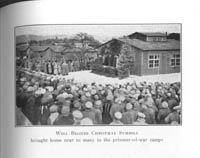
Prisoners assemble outside of a YMCA hall in an Austrian prison camp in preparation for their Christmas celebration. Dignitaries are standing on the steps of the building by the front door.
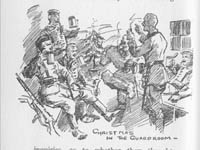
Prisoner of War guard duty was almost as monotonous for the guards as it was for the prisoners (although the penalties for German guards caught in the derilection of duty encouraged greater vigilance). In this drawing of the guard room at Magdeburg, German troops enjoy some holiday festivities with tankards of beer and a decorated Christmas tree.
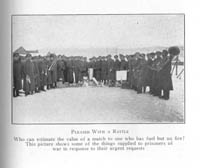
Members of a Russian band stand in the snow with their musical instruments and the contents of a WPA recreation chest displayed on the ground. An unidentified YMCA secretary in civilian clothing stands on the right hand side. The Association made every effort to provide Allied prisoners with materials they needed in prison camps.
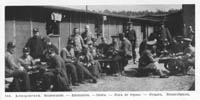
French and Russian prisoners relax outside their barrack in Koenigsbrueck one afternoon. The men are spending their time reading, playing cards, or engrossed in a chess game under the supervision of two German guards.
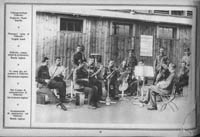
The prison orchestra at Doeberitz, composed of British prisoners, is about to give an outdoor concert in front of a barrack. Prisoners are equipped with a wide range of musical instruments and have wooden music stands, most likely produced in the prison carpentry shop.
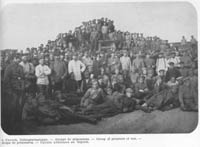
A group of Russian prisoners, along with German NCO's, pose for a photograph in the prison compound in Czersk. Many of the prisoners are standing on the roof of a barrack (note the window), which was one of the earthen dug out type in this camp.
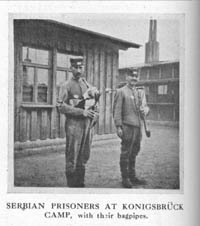
Scottish, Irish, and Canadian prisoners were not the only soldiers who carried bagpipes into battle. These two Serbian prisoners of war stand outside of their one-story wooden barracks at Koenigsbrueck with the bagpipes in hand. Note the identification badges on their field caps and the right breasts of their tunics.
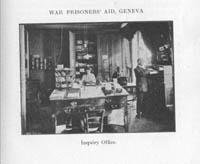
This was the Inquiry Office of the War Prisoners' Aid program in Geneva. Friends and family members could contact this office for information about missing loved ones behind enemy lines. The office worked through the WPA headquarters in belligerent capitals and Field Secretaeies to find out information about POW's. The Geneva office also coordinated information with the International Red Cross, who maintained records on POW's. Victor Schlaeppi supervised this office during the war.
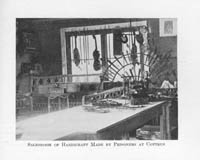
The American YMCA arranged expositions of prisoner handicrafts and sold these projects to provide POW's with a modest income. The prisoners at Cottbus made these handicrafts, which included baskets, wicker furniture, a violin, a balalaika, hats, spoons, pictures, and other goods.
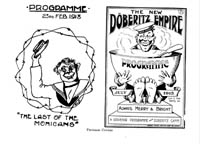
Examples of two program covers from the prison camp at Doeberitz. The cover on the left is from a theatrical performance of "The Last of the Mohicans," which the prisoners presented on February 23, 1918. The cover on the right is from a souvenir program from the New Doeberitz Empire for a July 1915 production. The smiling British sailor was the symbol of the camp and lived by the motto "Always bright and merry!"
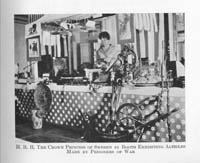
Crown Princess Margaret of Sweden hosted this exhibition of Allied prisoner of war handicrafts in Stockholm. The show displayed a variety of crafts produced by POW's including a model airplane, a spinning wheel, a windmill, a ship, a vase, baskets, canes, a mandolin, figurines, knick-knacks, drawings, and other items. The exhibition organizers sold these handicrafts to provide prisoners with some additional income.
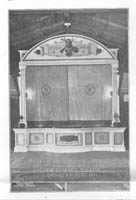
Due to the popularity of the theater, the Germans constructed the New Doeberitz Empire in a wooden buidling, which officially opened on September 8, 1917. The photograph shows the stage of the new theater.
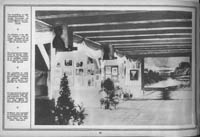
Prison camps often held art exhibitions which displayed the work of POW's. This is a general view of the exhibition of officers' work at Torgau in 1915, highlighting the paintings which featured portraits and landscapes. The exhibit also included decorative flowers and plants. Sometimes the art work was sold at POW exhibitions, which provided prisoners with extra income to improve their standard of living.
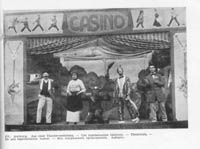
French prisoners pose for a photograph on stage in the theater at Amberg. Among this comedy troupe is a young "lady" and a bull. Theatricals played a critical role in bolstering prisoner morale in German prison camps.

Two clowns act out a comedy routine for a large group of French prisoners in the prison compound in Stuttgart II. Comedy acts were a welcome diversion for many disspirited Allied prisoners.
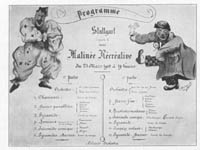
This French program describes a variety show offered to prisoners on the afternoon of March 21, 1915 in the Stuttgart II prison camp. The program featured acrobats, comedy acts, and musical performances in a two-part matinee.
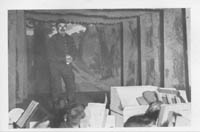
A French clown sings a tragic song accompanied by the camp orchestra during a variety show in the theater at Dyrotz. Theatrical performances were a critical part of social life in prison camps, both for the actors and the audience, especially for the latter since they gained the opportunity to escape from their confinement for an hour or two through theatrical entertainment.
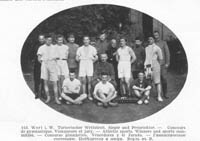
British, French, and Russian officers, who make up the Sports Committee at Werl, pose for a picture with several of the athletes who received awards for winning competitions that day. Sports days were a way to keep prisoners in shape and improve morale in prison camps.
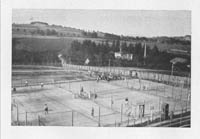
All three tennis courts are in action in this photograph of tennis matches in an unidentified German prison. The center court features a game of singles, while the other two matches are doubles. Tennis was one sport which allowed Allied prisoners to enjoy the weather and get some exercise.
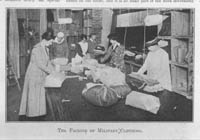
The British government assigned the Central Prisoners of War Committee, a branch of the British Red Cross and Order of St. John, responsibility for the care of British prisoners of war and interned civilians in Central Power prison camps. This department was responsible for sending clothing parcels to British prisoners of war.
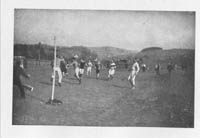
Prisoners attack a goal (as seen by the pole to the left) during a soccer match at a prison camp in Germany. Soccer was a very popular sport in prison camps as the prisoners organized leagues. Games usually drew a large number of spectators. As a result, soccer was a healthy pastime for players and provided entertainment for other POW's in the camp.
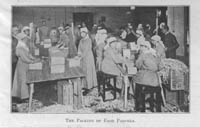
Women, working for the Central Prisoners of War Committee, pack parcels of food for British prisoners of war and interned civilians in German and Austrian prison camps. British prisoners received a three ten-pound food parcel every two weeks during their captivity.
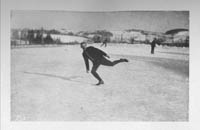
A French prisoner executes a jump while ice skating at an unidentified German prison camp. Two other POW's are skating behind him. While winters meant cold barracks and a struggle to keep warm for many prisoners, some POW's took advantage of the weather for some healthy exercise.
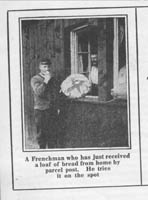
A French prisoner of war has just received a bread parcel at the parcel post office of a German prison camp. He immediately tastes a piece of the loaf. German censors inspected the bread for the concealment of contraband before turning over the parcel.
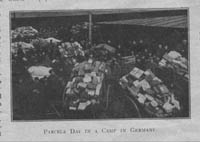
Nine wagon loads of parcels sit outside the parcel post office of a German prison camp. These packages will be distributed after inspection by German censors for contraband.
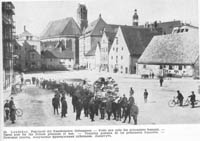
French prisoners transport a shipment of parcels in the town square in Landshut. The town church is in the background of the photograph and the activity has caught the attention of a number of German civilians.
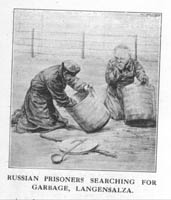
Food conditions were harsh for Russian prisoners of war in German prison camps who did not receive food parcels from home. This drawing depicts two Russian POW's scrounging in garbage cans for scraps of food to supplement their daily rations.
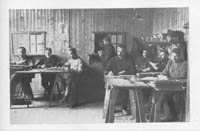
French prisoners clerk at the prison bank at Guestrow. POW's earned money while working on labor detachments and received funds from friends and family back home. POW's did not receive legal currency but instead used Lagergeld, money which could be used for purchases inside the prison camp. By eliminating access to legal tender, German authorities hoped to reduce opportunities for bribery and funding escape attempts.
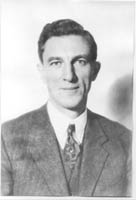
Photograph of a younger Darius A. Davis (1883-1970), an American YMCA WPA Secretary in France and Italy early in the war, Davis became the Senior American YMCA Secretary in France when the United States joined the Allies in 1917.
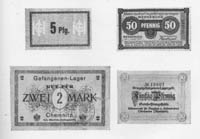
Samples of Lagergeld from four different prison camps in Germany, including Merseberg, Chemnitz, and Oberhausen in the Rhineland. POW's could use these currencies to make purchases within these prison camps, but the money was worthless outside of the camp compound.
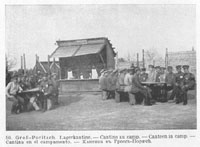
Russian prisoners sit at two large tables near a small outdoor canteen in the prison compound at Zittau (Gross Poritsch). Note the white identification badge on the left breast pocket of the Russian POW's. This badge may have identified the prisoners' barrack or detachment number.
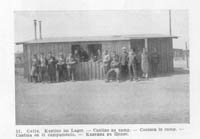
French and Belgian prisoners, and civilian internees, enjoy refreshments at the canteen at the prison camp at Celle. The canteen appears to be well stocked with provisions.
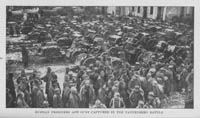
Hundreds of Russian prisoners of war march past captured gun carriages and German soldiers and into captivity in Germany. After their initial success in the invasion of East Prussia in August 1914, the Germans mounted a massive counter-offensive and destroyed a Russian army at the Battle of Tannenberg.
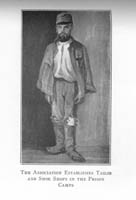
This drawing shows a destitute French prisoner of war dressed in rags. The YMCA provided equipment and cloth to set up tailor shops in prison camps to ensure that prisoners had protection against the elements. The shops also provided skilled tradesmen with the opportunity to practice their trade and earn some extra money.
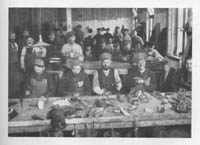
French and Russian prisoners work on shoes and boots in the cobbler shop at Merseberg. The men are busy making new shopes and boots or repairing worn out footwear. These skilled laborers provided an important service in the prison camps and unskilled prisoners gained the opportunity to learn a new trade during their captivity.
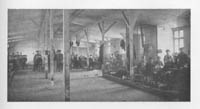
Tailors are busy at work at the back of this workshop while cobblers labor behind the screened-wire wall to the right in the prison camp at Stendal. Skilled laborers supported the operation of prison camps by making and repairing shoes, boots, and clothing.
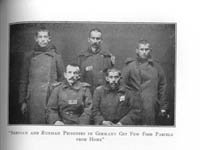
These Serbian prisoners of war received few, if any, parcels to supplement their rations in German prison camps, due to the collapse of their government. Russian, Serbian, Romanian, and many Italian POW's faced starvation on a daily basis because their countries were overrun by the Central Powers.
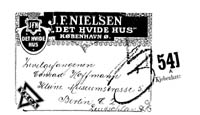
This was a food parcel label from the YMCA warehouse in Copenhagen addressed to the War Prisoners' Aid headquarters in Berlin, Germany. E. G. Wilson, an American Association secretary, supervised the distribution of food and clothing parcels from Denmark to Allied prisoners in Germany.
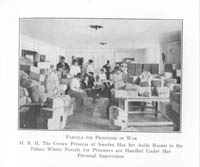
Crown Princess Margaret of Sweden set aside rooms in the royal palace to serve as a warehouse for parcels destined for Allied prisoners of war in German prison camps. An English princess by birth, Princess Margaret took special interest in the care of British POW's and worked closely with YMCA secretaries to make sure British prisoners received relief packages.
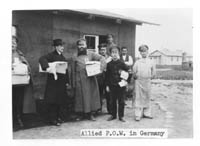
An unidentified YMCA secretary (in civilian clothing) distributes Red Triangle relief parcels to Russian prisoners of war in a German prison camp. Russian prisoners received very little support from home despite their great need for supplemental food rations.
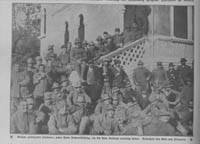
A group of Italian prisoners at rest pose for a photograph with some German soldiers. Several of the Italian prisoners have lost their uniforms but were unable to evade capture.
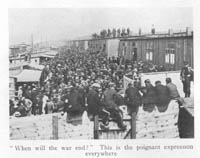
Interned Allied civilians mill about the street of a German civilian internment camp. Several shops on the left side of the street appear to be doing a brisk business in trade.
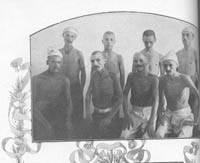
A group of eight Italian prisoners of war, recently released from Austrian prison camps, show the ill effects of tuberculosis on their emaciated bodies. The poor diets these POW's received in prison camp contributed to the onset of TB.
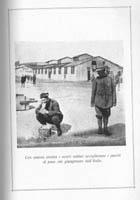
A squatting Italian prisoner tears into a loaf of bread while another Italian POW watches in the prison compound at Mauthausen. By the end of the war, the Allied blockade had a serious impact on the quantity and quality of rations that the Austrians provided to prisoners. This desperate situation was compounded by the Italian government's decision to restrict parcel shipments to POW's in the Dual Monarchy after the Caporetto fiasco.
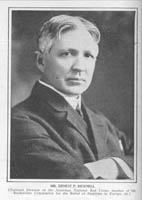
Ernest P. Bicknell (1862-1935) was the Vice President of the American Red Cross during the First World War and traveled to Europe several times to assess refugee relief work.
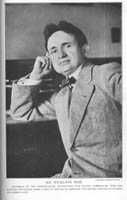
Wycliff Rose (1862-1931) supported relief operations in Europe through the Rockefeller Foundation during World War I and founded the Commission for the Relief of Poland.
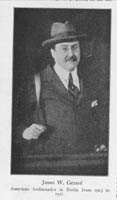
Photograph of Ambassador James W. Gerard (1867-1951), United States ambassador to Germany from 1913 to 1917.
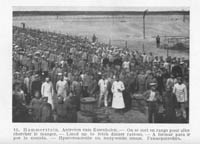
Thousands of Russian prisoners line up for their dinner rations in the prison compound at Hammerstein. Their soup will be laddled from the large wooden barrels at the front of each line.
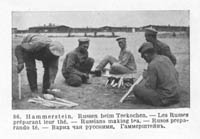
Five Russian prisoners cut up wood scraps to prepare a fire to boil water to make tea in the prison compound at Hammerstein. The wooden barracks in the camp stand in the background.
